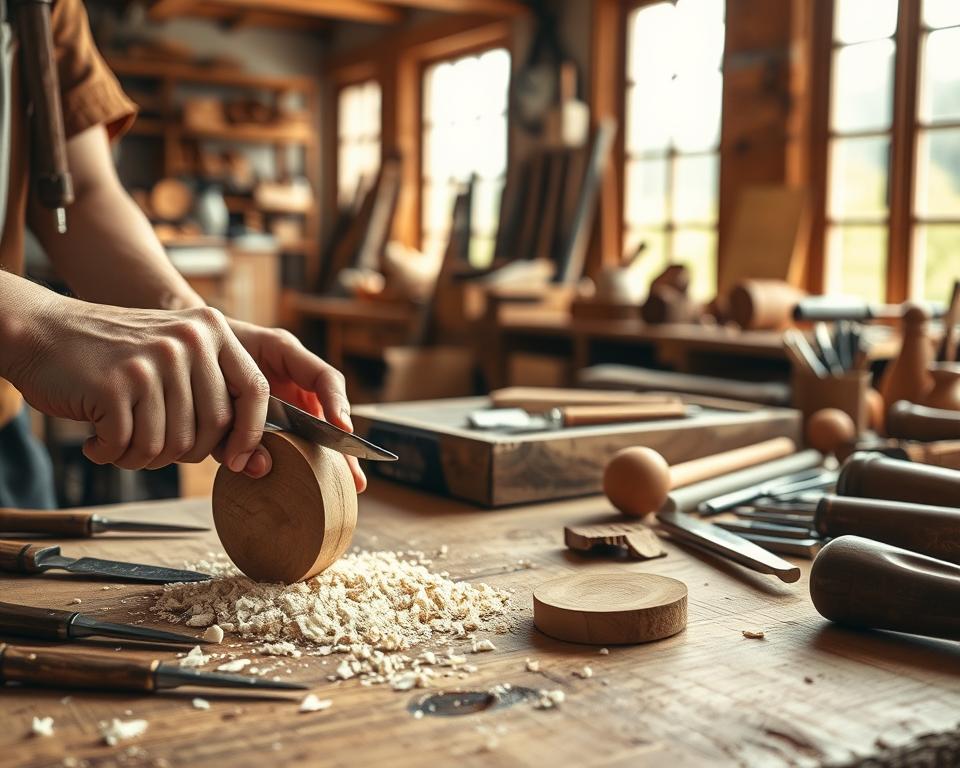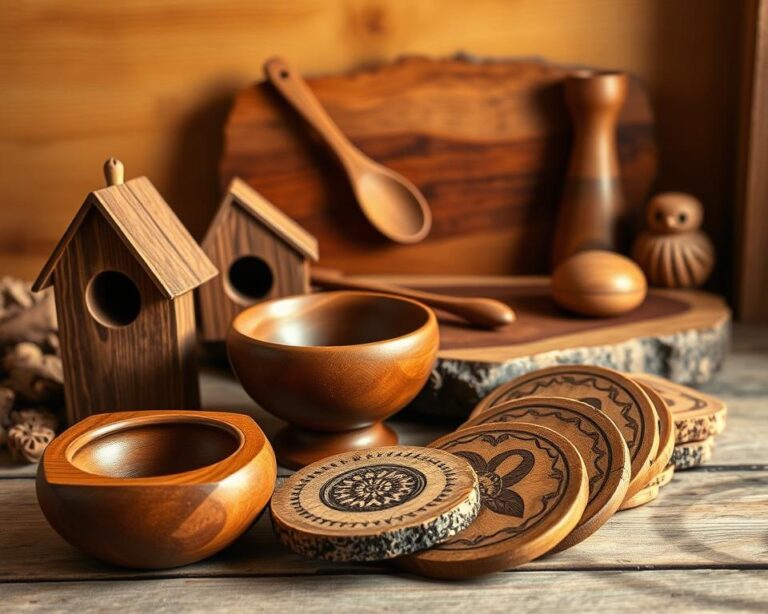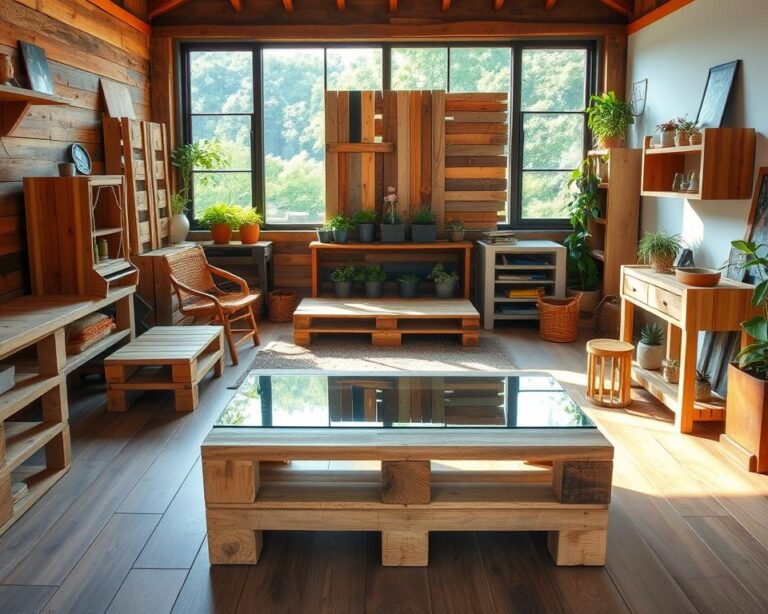About 70% of U.S. adults feel stressed every day. Wood carving is a fun way to lessen this stress, making it great for beginners. It’s not only a way to get creative but also helps with staying calm and focused. In this article, you’ll learn the basics of wood carving, including the necessary tools and techniques. Ready to begin your adventure in this timeless craft? Let’s get started!
What is Wood Carving?
Wood carving is a mix of art and craft with deep roots. It shows how different cultures have shaped it into a way to express themselves. This craft is not just about making things. It’s about carrying on traditions and making pieces that tell stories.
Learning about its history helps us appreciate our own carving projects more.
Brief History of Wood Carving
Wood carving began with ancient people making sacred objects and practical tools. In ancient Egypt, carvers made detailed pieces for furniture and tombs. Over time, unique styles popped up, reflecting each culture’s beliefs and technology changes.
Wood carving’s history is a rich tapestry showing how art evolves with society.
The Art of Wood Carving Today
Nowadays, wood carving combines old and new styles in exciting ways. Carvers experiment with different woods, tools, and finishes. This mix of old traditions and new ideas makes wood carving very appealing today.
It’s a craft that invites everyone, from hobbyists to pros, to express their creativity. And it keeps our connection to this ancient art alive.
| Period | Characteristics | Key Techniques |
|---|---|---|
| Ancient Civilizations | Functional and ceremonial carvings, often symbolic | Hand tools, basic chiseling |
| Middle Ages | Religious and decorative art, detailed embellishments | Reliefs, inlays, and intricate designs |
| Modern Era | Eclectic styles, blending traditional and contemporary | Power tools, mixed media, and innovative finishes |
Essential Tools for Beginners
Jumping into wood carving means getting to know the right tools first. If you’re starting, it’s important to have the right wood carving tools. This includes carving knives, safety gear, and some extra handy items.
Recommended Carving Knives
Start by focusing on the most important knives. Straight blade knives are great because they work well for many projects. For more detailed work, specialized whittling knives are perfect. They can help you make intricate designs easily and help you get better at carving.
Safety Equipment for Carving
Your safety is the most important thing. Wearing the right safety gear keeps you safe while you work. Make sure to use sturdy gloves, goggles, and a dust mask. This gear not only keeps you safe but also lets you concentrate on creating art without worry.
Additional Helpful Tools
Besides knives and safety gear, there are more tools that can help you. Sharpening stones keep your knives sharp for clean cuts. Clamps hold your work steady, giving you more control as you carve. These extra tools, along with your carving knives, will make your projects go smoothly and be more fun.
Choosing Your First Wood
Beginning wood carving? It’s important to pick the right wood. The type you choose affects how much you enjoy carving. Different woods have different features. So, it’s key to know about them before starting.
Types of Wood for Carving
There are many woods for carving. Softwoods like basswood are popular among beginners. It’s easy to work with because of its fine grain. Softwoods are great for learning without getting frustrated.
Softwoods vs. Hardwoods
Softwoods and hardwoods are quite different. Softwoods, including pine and cedar, are simpler to carve and good at holding details. They’re great for beginners. Hardwoods, like oak or mahogany, are tougher due to their density. They require more skills and tools. Starting with softwoods is a good idea to build your skills.
Best Wood for Beginners
If you’re just starting, basswood and butternut are good choices. They’re easy to carve and good for detailed projects. Basswood is especially loved for its smooth feel and low resin content. By choosing these, you’ll likely enjoy carving more and do better in your first projects.
Basic Techniques to Get Started
Learning basic wood carving techniques is the first step on your journey. It’s very important to know how to hold your knife correctly for both precision and safety. Knowing different carving cuts also boosts your skills. Starting with easy patterns can make it fun and help you get better and more confident.
Knife Grip and Control
Holding your carving knife the right way is crucial for success. A good grip helps you control your cuts better. Put your thumb on one side of the blade and your fingers around the handle. This allows you to move the knife easily for detailed work. Try out various grips to see which works best for you.
Understanding Carving Cuts
Wood carving has many different cuts, each with its own purpose. Here are some basic ones you should learn:
- Push Cut: Pushing the knife away from you, good for shaping and refining edges.
- Pull Cut: Pulling the knife toward you, great for controlled shaping and details.
- V-Cut: Cutting at an angle to make a V-shape, ideal for decorative elements.
Practicing these cuts will make you much better at woodworking.
Patterns and Designs for Beginners
Starting with simple wood carving patterns is great for beginners. Try making things like animals, spoons, or small decorations to learn the basics. These patterns give you clear steps and let you be creative. Using them, you can watch yourself improve and enjoy making unique items.
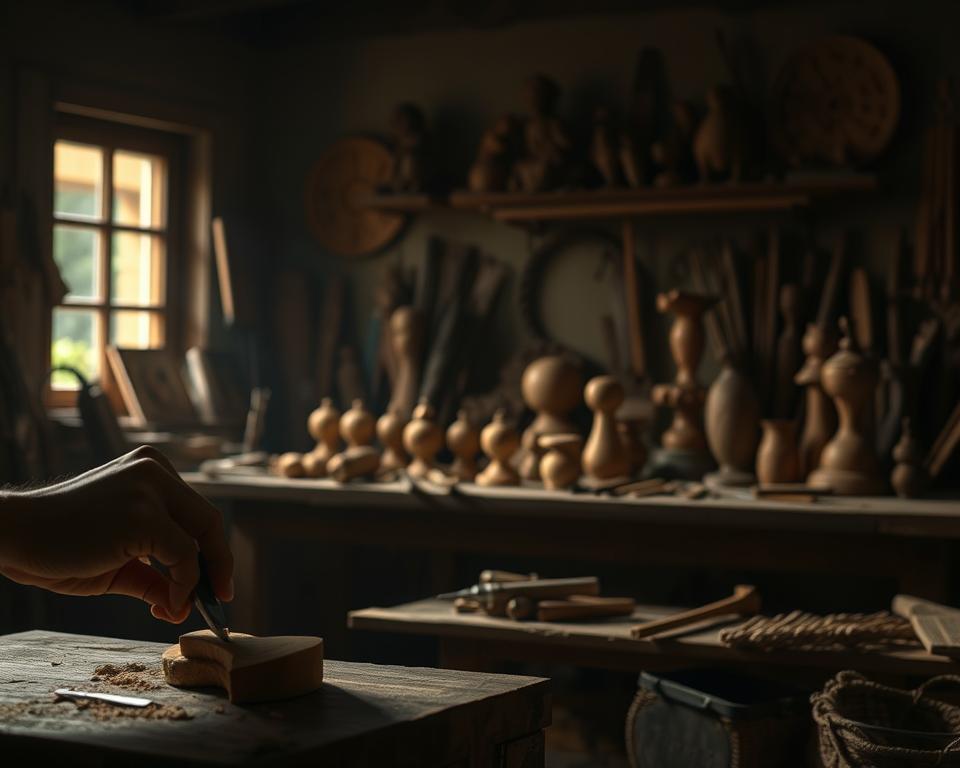
Setting Up Your Carving Space
Setting up a special area for wood carving is key for newbies. A good space makes crafting better and keeps you safe. Let’s look at how to make a comfy spot that helps you be creative and productive.
Creating a Safe Working Environment
Safety is always the most important thing in a wood carving area. Start by making sure your space is free of dangers. Get rid of mess that could mess with your work. Make sure the air moves well in your workspace to avoid breathing in dust. Wearing things like gloves and goggles can help keep you from getting hurt.
Organizing Your Tools
Having your tools in order makes work easier and lets you focus on your project. Think about using toolboxes or racks on the wall to keep your knives and tools handy. Putting tools that are alike together helps you work better and keeps you from losing important stuff. A clean space makes carving more fun.
Lighting and Comfort Considerations
Good lighting is crucial in your wood carving area. It lets you see small details and avoid mistakes. Use natural light and lamps that you can move to get the best lighting. Being comfortable matters, too; have a chair that’s good for your body and a solid table for long sessions of carving. A good workspace makes carving a better and more effective activity.
Learning Resources for Beginners
Improving your wood carving skills can be exciting. There are many resources to help you learn. You can pick what works best for you, like watching videos or reading books. Also, connecting with other carvers is crucial for growth.
Online Tutorials and Videos
Online, there’s a wealth of tutorials and videos on wood carving. They show expert carvers in action, making it easier to grasp difficult techniques. These resources cover everything from basics to more complex skills. You can also find interactive courses online to practice with guidance.
Recommended Books for Wood Carving
Books are great for learning more about wood carving. They offer step-by-step guides and inspiring projects. Titles like “The Complete Book of Wood Carving” and “Carving Basics” are highly recommended. These books not only teach but also encourage trying new styles.
Joining Local Wood Carving Clubs
Joining a wood carving club has many benefits. It’s more than learning; it’s about connecting with others who love carving. Club members share tips, demonstrate techniques, and give feedback on your work. Such clubs are great for making friends and finding mentors.
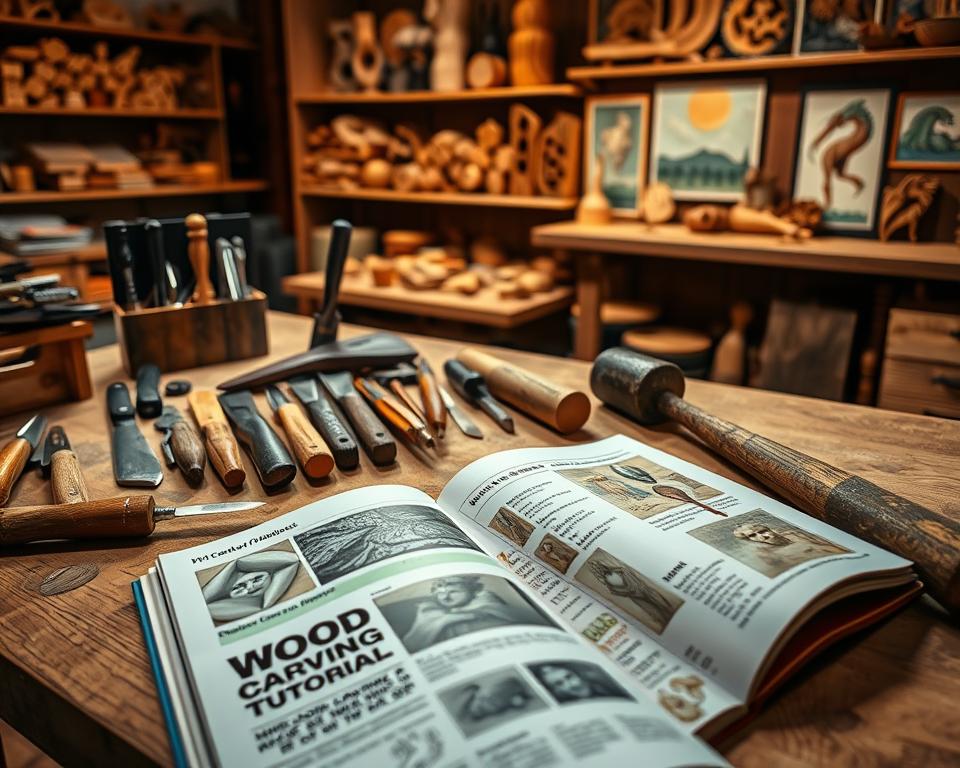
Project Ideas for Beginners
Starting with wood carving is both exciting and fulfilling. You can gain confidence and improve your skills with simple projects. Here, you’ll discover beginner-friendly wood carving projects. They’re easy and offer a solid start for more complex tasks. These ideas are both fun and useful.
Simple Whittling Projects
Whittling is a great way to start wood carving. You could try making:
- Handcrafted spoons
- Decorative animals
- Simple figurines
These projects need just a few tools and are great for building skills and being creative.
Fun Decorative Items
Make your space more interesting with simple wood carving projects such as:
- Wood keychains
- Picture frames
- Small wooden bowls
Creating these items is fun and they’re also useful.
Gifts and Personalized Items
Handmade gifts are always special. You can make personalized things like:
- Engraved wooden plaques
- Customized coasters
- Unique ornaments
Personalized gifts show how much effort you put in. This makes your beginner wood carving gifts truly meaningful.
Trying out these project ideas helps you get better at carving. Plus, it’s joyful to make something all your own. Enjoy crafting and see how your skills grow!
Tips for Success in Wood Carving
Starting your journey in wood carving opens up many opportunities to get better. It’s key to learn from every challenge and mistake. Taking on mistakes as part of learning and applying good techniques will greatly help you improve as a wood carver.
Learning from Mistakes
Every craftsman faces challenges. Turning these into learning opportunities is key to getting better. Thinking about what didn’t work provides essential wood carving practice advice. This helps make your next projects more successful. Every time you carve, keep an open mind. Let your errors show you how to improve your skills.
Patience and Practice
Wood carving takes patience, especially when you’re starting. Give yourself the time needed to polish your skills, knowing you won’t master it overnight. Practicing regularly is the foundation of success. Adding practice sessions to your routine builds your confidence and skill, which is crucial for beginners.
Importance of Regular Breaks
Taking breaks often is really good for your focus and creativity. Stepping back from your work helps refresh you and gives you a fresh outlook. These breaks help avoid tiredness and improve your work. Finding a good balance between work and rest makes carving more fun and effective.
Maintaining Your Tools
It’s vital to take good care of your wood carving tools. Doing so improves your work and keeps you safe. This part will show you how to sharpen, clean, and fix your tools, providing vital tool maintenance tips.
Sharpening Your Knives
Sharp knives are key for good carving. A blunt blade makes you push harder, raising the chance of getting hurt. Always use a top-notch sharpening stone or a honing guide. Checking your blades regularly helps avoid trouble during carving.
Cleaning and Storing Tools
Always clean your tools after using them to get rid of wood bits and moisture. This stops rust and keeps them lasting longer. Keep them in a dry, safe spot to dodge any harm. A special toolbox or drawer will help keep your area tidy and your tools within reach.
Repairing Damaged Tools
Even with great care, tools can get damaged. Knowing how to fix them saves both time and money. Minor repairs might include reshaping knife edges or securing loose parts. Keeping tools in prime condition improves both your carving and safety.
| Maintenance Task | Recommended Frequency | Key Tips |
|---|---|---|
| Sharpening Knives | Every few projects or as needed | Test sharpness by slicing a piece of paper |
| Cleaning Tools | After every use | Use a damp cloth and dry immediately |
| Repairing Tools | As soon as damage is noticed | Assess damage and apply appropriate fix |
Common Mistakes to Avoid
When you start wood carving, avoiding common mistakes can make your journey better. Many starters struggle with the same issues. This can make things tough and slow down progress. Learning about these problems will let you handle your projects better.
Overdoing It with Complex Designs
Trying complex designs too early is a big mistake. Beginners often want to tackle hard projects to impress. It’s better to start with easy shapes. This helps you learn basic skills and build confidence. You can try harder carvings later when you’re more skilled.
Ignoring Safety Protocols
Safety is crucial in wood carving. Not following safety rules can cause accidents and injuries. Always use protective gear like gloves and goggles. Keep your work area clean and tools sharp. By doing this, you can avoid accidents and make your carving times productive.
Not Using Proper Tools for the Job
Choosing the wrong tools is a common error for new carvers. Each tool has its own purpose. Using the wrong one can mess up your work or harm the wood. Get to know your tools and choose the right ones for the task. This will improve your work and help you avoid mistakes.
Celebrating Your Progress
Starting your wood carving journey is exciting. Remember, it’s important to celebrate what you achieve. Feeling proud of your creativity is key. Sharing your art with others can really boost this feeling. You can use social media or wood carving forums for this. Showing your work and getting feedback makes a supportive space. It connects you with people who love carving too.
Sharing Your Work Online
When you share your carvings online, you get helpful tips and new ideas. Talking to other carvers builds a community. It pushes you to try fresh challenges and learn. Sharing your craft and thoughts online can be very fulfilling. It makes keeping track of your progress rewarding.
Participating in Carving Competitions
Joining carving competitions is a great way to mark your progress. These events are about more than just competing. They let you show off your skills. You also get to see other carvers’ work, which can teach you a lot. The friendships made at these events are very encouraging.
Keeping a Wood Carving Journal
Keeping a journal of your wood carving journey is a smart move. In it, you can note down new techniques and completed projects. You also can write about what each piece means to you. This helps you understand your art journey better. A journal motivates you and becomes a precious record of your growth.

